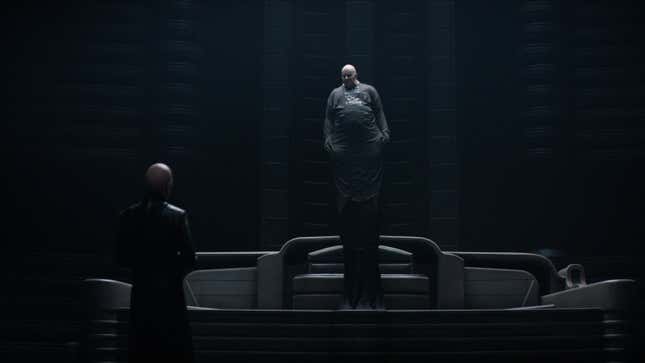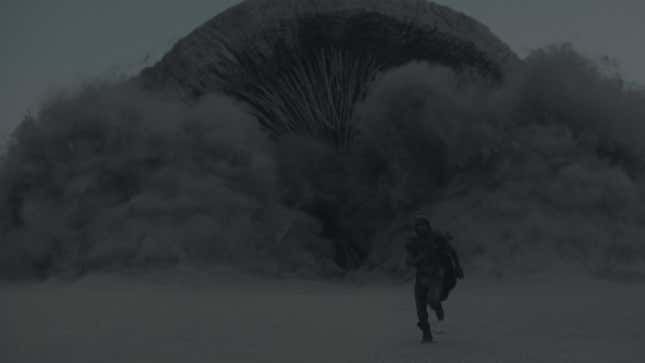When Denis Villeneuve’s Dune arrives in theaters and on streaming services October 22, it will do so while laboring under a number of shadows. There are the past adaptations of Frank Herbert’s landmark sci-fi novel, obviously—both David Lynch’s flawed but fascinating effort in 1984, and the unrealized (and thus unlimited) potential of Alejandro Jodorowsky’s stab at the material a decade earlier.
There are Villeneuve’s own grumblings about the way his movie has been treated by distributor Warner Bros. and studio Legendary, including his unhappiness about the film’s hybrid HBO Max release, and the fact that this is, by his own admission, only half a story. The book’s second half is being reserved for production until after everyone involved is satisfied that the classic franchise hasn’t birthed yet another expensive flop.
But the biggest strike against Dune is probably the reputation of Dune itself. Herbert’s novel is frequently both praised and feared for its density, for its far-flung sci-fi settings, and for its perfect happiness to toss out long strings of constructed words (“Bene Gesserit,” “Kwisatz Haderach,” and “gom jabbar” all appear in the first 10 pages) while discussing heady themes of politics, religion, ecology, and more.
And while Herbert’s reputation for the cryptic is at least partially overblown—the book remains a much-read classic in part because its author knows how to ground his space nonsense in eminently relatable family dynamics—Dune nevertheless can seem as intimidating to the newcomer as an Arrakis sandstorm. Hence this primer, meant to help you tell your mentat from your stillsuit, and ensure that you know everything you need to know about Paul Atreides’ universe before sitting down with Villeneuve’s film on October 22.
Where and when does Dune take place?

Herbert’s novel kicks off at a point far enough in the future as to be functionally unrecognizable for the majority of us; by now, humanity exists, largely under the control of a feudal system overseen by an ominous Imperial government, on a wide variety of worlds that exist largely isolated from each other in deep space. (For reasons we’ll get to in a second, travel between these planets is tightly regulated; take it as read that life for most people skews more toward “peasant” than “space adventurer.”)
The central characters of the novel (and especially the material that makes up Villeneuve’s first film) are all attached to one of the Great Houses, feudal lords who orbit politically around the Emperor, who manipulates their various squabbles and feuds for his own benefit. Most prominent among the latter is the long-running war between House Atreides and House Harkonnen, bitter and hated rivals who each seek the other’s destruction through means both covert and overt. Shadowy groups—most notably the Bene Gesserit sisterhood, who try to portray themselves as a simple group of public servants, but who are in actuality some of the galaxy’s most dedicated schemers—operate at the edges of it all, constantly maneuvering for advantage
And all of it, every world, revolves, in some way or another, around the spice. Herbert takes his time laying out everything that melange, the drug that so much of Dune’s conflict centers on, can do. But even its bare minimums make it the most valuable resource in the universe: It makes space travel possible. It extends human life spans considerably. It is highly addictive. And it is produced on exactly one world in the universe: Arrakis. Or, as it’s known in less formal reckoning: Dune.
Who are the Atreides?

The Atreides are the good guys, basically.
House Atreides are the viewpoint characters for much of Dune, and they are, by the metrics of the universe they live in, almost ridiculously noble and pure. That all rolls down from Duke Leto, who runs his House—part military dictatorship, part economic engine—by cultivating love, loyalty, and camaraderie among his men. That includes Gurney Halleck, a hybrid singer-soldier-spy whose total loyalty to the Atreides is a mixture of genuine love for the family and hatred for their Harkonnen rivals, who tortured him in his youth.
There’s also Thufir Hawat, the family’s aging spymaster and mentat—i.e., a human being who’s trained themselves to have some of the same recall, calculation speed, and logical faculties as a computer—Duncan Idaho, a soldier who will gain ridiculous amounts of importance as the series progresses; and Dr. Wellington Yueh, the family doctor, who has received “Imperial Conditioning” that makes it impossible for him to harm anyone in his care.
All of these various fathers/father figures have been involved in the education and raising of Leto’s son, heir, and only child, Paul Atreides. In case his prominence on all those posters didn’t make it clear, Paul is a big deal in the world of Dune. He’s 15 when the book starts, and we meet him already trained in swordplay, warfare, and many more subtle arts—the latter instilled in him by his mother, Jessica, the Duke’s beloved concubine, and a member of the Bene Gesserit sisterhood. Paul knows when people are lying. Paul asks questions that continually stun minds much older than his with their insight. Paul dreams of the future.
Lately, he’s been dreaming of Arrakis, where the Emperor has just ordered his father to transplant their entire House—leaving the lush, green world of Caladan behind—in order to take over spice production on Dune.
Who are the Harkonnens?

The Harkonnens are the bad guys, of course.
Hated rivals of House Atreides, the Harkonnens are ostensibly the losers of the Emperor’s recent order, since they were the ones in charge of Arrakis previously, and are thus the ones losing control over the universe’s most valuable commodity. But Baron Vladimir Harkonnen—depraved, rotund, surprisingly buoyant—is a master schemer, and his counter attack on the Atreides is already in the works as the novel begins. The Baron is assisted in this vendetta by Piter De Vries, House Harkonnen’s own mentat, who shares with his boss a taste for sadism and convoluted plotting.
Although he lacks any acknowledged children, the Baron does have two potential heirs: his nephews “Beast” Rabban and Feyd-Rautha. (The latter was played by Sting in the Lynch version of Dune, for those of you playing along at home.) Both are Harkonnens by blood—which is to say, raging psychopaths. But Feyd-Rautha is portrayed as at least moderately more palatable to regular humans (and Dune’s native Fremen) than his monstrous and murderous brother.
Who are the Fremen?

The Fremen are the native (or at least more native) people of Arrakis, and the only ones who actually know how to survive on the harsh desert world without significant external assistance. Much of the Fremen culture is—understandably, for a civilization built on a world with little-to-no naturally occurring water—devised around an almost religious reverence for the wet stuff. (If a Fremen spits at your feet, it’s not contempt they’re showing; it’s a deep enough respect that they’re willing to share their water with you.)
The novel’s most prominent Fremen are Stilgar, a local leader who offers aid to House Atreides when it becomes clear that they are not murderous, slaving scum like the previous landlords, and Chani, a young woman from Stilgar’s tribe who has been performing a recurring role in Paul Atreides’ recent dreams. Both carry the Fremen’s most prominent trait: pure blue eyes, with no whites visible—a physical symptom of life-long exposure to the spice.
The Fremen also have a whole bunch of prophecies they adhere to about coming Messiahs who might someday turn Dune into less of an arid hellworld—most of them implanted in their culture hundreds of years earlier by the Bene Gesserit, on the theory that you never know when having a useful bit of religious dogma to exploit centuries down the line might come in handy to save a sister’s life.
Okay, but what about the sandworms?

Dune’s most prominent fauna are also its most mysterious: Nobody knows why the giant sandworms that control much of the planet’s surface—often swallowing whole mobile spice factories in a single giant gulp—do what they do, where they come from, or what, if any, connection they have to the planet’s spice deposits. (All anyone does know is that spice production is a constant race ahead of the next worm attack.)
As a symbol of Arrakis’ power, beauty, and total indifference to human life, the worms loom monstrously over Dune as a whole. Their secrets unlock many of the deeper realities of Herbert’s ideas about ecology and cosmology. They are also big goddamn sandworms that will eat you without a moment’s hesitation, so, y’know: Careful where you step.
What’s a stillsuit? A Kwisatz Haderach? What are all these made-up words?

A brief glossary of stuff Frank Herbert made up for Dune, and why it matters for the movie:
- The Butlerian jihad: This is Herbert’s way of explaining why there aren’t any computers in the Dune universe. There used to be, it apparently got pretty bad, and now we have religious doctrines, mentats, and specially trained space Navigators instead. The most important immediate consequence of this bit of world-building is that it makes spice even more valuable, since the Guild navigators require it to fly properly, and without it, interstellar trade and travel grinds to a halt.
- Kwisatz Haderach: The hypothetical end goal of the Bene Gesserit’s centuries-long breeding program, meant to produce a man who can tap into the same genetic memories that senior Bene Gesserit have access to—only more so. The messiah, basically.
- The gom jabbar: A needle filled with instantly acting poison, used in tests of “humanity” by the Bene Gesserit. Not the name of the pain box also used in those tests, which doesn’t get a fancy name, unfortunately.
- Stillsuits: Water-conserving suits that are one of the main ways the Fremen survive on Arrakis. A good stillsuit will supposedly stop you from losing more than a thimbleful of water from your body every day, filtering sweat, urine, feces, and more in order to keep you hydrated under the brutal Arakeen sun.
- Crysknife: The signature weapon of the Fremen, a polished and sharpened sandworm’s tooth. Considered sacred; if one is drawn from its sheath, tradition dictates it must taste blood before being put back.
- Atomics: Nukes. These are capital “I” Illegal to deploy in warfare, and if you’re caught using them, you’re liable to face a visit from…
- The Sardaukar: The Emperor’s elite troops, and one of the instruments by which he imposes his imperial will. Considered to be the most deadly soldiers in the universe.
- CHOAM and the Landsraad: The stock market and Congress, respectively; both are made up almost entirely of heads of the Great Houses, who use them both as proxies for their long-standing fights.
How weird does it get from here?

Pretty damn weird. Despite its sci-fi trappings, Dune proper is actually a pretty conventional coming-of-age story, tracking Paul’s journey from promising youth to a place at the very center of the universe. Herbert’s later books get considerably stranger, though, to the extent that we can’t help but root for the franchise to take off, just to see some of this stuff make it to the screen.
After all, who wouldn’t want to see hundreds of Jason Momoas, all acting confused about their place in the universe? Or a looming God-Emperor who’s no longer even remotely human? Or the full blossoming of Herbert’s increasingly weird views on sexual politics, culminating in a crew of female soldiers so good at sex that they use it as a brainwashing tool? (Okay, we can probably skip that one.) The success of Dune allowed Herbert to let his imagination run wild once upon a time, creating one of the strangest and most far-flung science fiction franchises ever. It remains to be seen whether Villeneuve’s faithful treatment of that text can follow in their increasingly odd footsteps.
